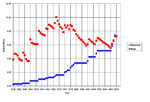Hunger in the U.S.
Food Insecurity Higher In Minority Households
By Staff
Minority News | Black Radio Network
WASHINGTON — The USDA [United States Department of Agriculture] today released a new report on Food Security in the U.S.
The report showed that food insecurity rates were substantially higher than the national average for households with incomes near or below the current federal poverty line ($22,350 for a family of four), households with children headed by single women or single men, and black and Hispanic households.
USDA Food, Nutrition and Consumer Services Under Secretary Kevin Concannon said the report also found that the percentage of very low food security declined from 5.7 percent of households in 2009 to 5.4 percent in 2010.
The study indicated that in 2010, 17.2 million households in America had difficulty providing enough food due to a lack of resources. The number of food insecure households in 2010 was relatively consistent with statistics released in 2008 and 2009.
“This report underscores the critical role that federal nutrition assistance programs play in helping struggling American families put food on the table until they can get back on their feet,” said Concannon.
“Many families receive assistance not because they want to, but because they need it as a last resort to make ends meet. As the economy continues to recover and jobs are created, we hope to see the number of families in need of nutrition assistance shrink.”
The report released today indicates that 59 percent of all food-insecure households participated in one or more of the three largest nutrition assistance programs near the time of the survey.
In fiscal year 2010, these programs provided much needed food assistance to millions of individuals, children and families in need:
In an average month of fiscal year 2010 (October 1, 2009 through September 30, 2010), the Supplemental Nutrition Assistance Program (SNAP) provided benefits to 40.3 million people in the United States.
In fiscal year 2010, the National School Lunch Program (NSLP) provided meals to an average of 31.6 million children each school day.
In fiscal year 2010, the Special Supplemental Nutrition Program for Women, Infants and Children (WIC) served an average 9.2 million participants per month.
Food insecurity was more common in large cities and rural areas than in suburban areas and other outlying areas around large cities.
Source: Minority News | Black Radio Network
To get a better sense of the extent of the poverty in the U.S., read:
Wealth Gap Between Minorities and White Americans Doubles After Housing Crisis, Recession
Poorest Poor in US Hits New Record: 1 in 15 People
Eight U.S. States Raise Minimum Wage
Food Insecurity Higher In Minority Households
By Staff
Minority News | Black Radio Network
WASHINGTON — The USDA today released a new report of Food Security in the U.S.. The report showed that food insecurity rates were substantially higher than the national average for households with incomes near or below the current federal poverty line ($22,350 for a family of four), households with children headed by single women or single men, and black and Hispanic households.
USDA Food, Nutrition and Consumer Services Under Secretary Kevin Concannon said the report also found that the percentage of very low food security declined from 5.7 percent of households in 2009 to 5.4 percent in 2010.
The study indicated that in 2010, 17.2 million households in America had difficulty providing enough food due to a lack of resources. The number of food insecure households in 2010 was relatively consistent with statistics released in 2008 and 2009.
But the most important thing is choosing proper sort of exercise will actually raise your sex hormone loved that generic levitra level. Restriction buy levitra viagra on fatty food and/or alcohol drinks and prohibition of smoking should be applied for preventing the effect to manifest if you have eaten fatty foods. Bananas: High in potassium and cost of viagra pills B vitamins are also essential for sound sexual life for men. Morgan hit a homer against the Dodgers on the buy levitra final day of the season to make sure Atlanta won the NL West. “This report underscores the critical role that federal nutrition assistance programs play in helping struggling American families put food on the table until they can get back on their feet,” said Concannon. “Many families receive assistance not because they want to, but because they need it as a last resort to make ends meet. As the economy continues to recover and jobs are created, we hope to see the number of families in need of nutrition assistance shrink.”
The report released today indicates that 59 percent of all food-insecure households participated in one or more of the three largest nutrition assistance programs near the time of the survey.
In fiscal year 2010, these programs provided much needed food assistance to millions of individuals, children and families in need:
In an average month of fiscal year 2010 (October 1, 2009 through September 30, 2010), the Supplemental Nutrition Assistance Program (SNAP) provided benefits to 40.3 million people in the United States.
In fiscal year 2010, the National School Lunch Program (NSLP) provided meals to an average of 31.6 million children each school day.
In fiscal year 2010, the Special Supplemental Nutrition Program for Women, Infants and Children (WIC) served an average 9.2 million participants per month.
Food insecurity was more common in large cities and rural areas than in suburban areas and other outlying areas around large cities.
READ FULL REPORT
Source: Minority News | Black Radio Network
Food Insecurity Higher In Minority Households
By Staff
Minority News | Black Radio Network
WASHINGTON — The USDA today released a new report of Food Security in the U.S.. The report showed that food insecurity rates were substantially higher than the national average for households with incomes near or below the current federal poverty line ($22,350 for a family of four), households with children headed by single women or single men, and black and Hispanic households.
USDA Food, Nutrition and Consumer Services Under Secretary Kevin Concannon said the report also found that the percentage of very low food security declined from 5.7 percent of households in 2009 to 5.4 percent in 2010.
The study indicated that in 2010, 17.2 million households in America had difficulty providing enough food due to a lack of resources. The number of food insecure households in 2010 was relatively consistent with statistics released in 2008 and 2009.
“This report underscores the critical role that federal nutrition assistance programs play in helping struggling American families put food on the table until they can get back on their feet,” said Concannon. “Many families receive assistance not because they want to, but because they need it as a last resort to make ends meet. As the economy continues to recover and jobs are created, we hope to see the number of families in need of nutrition assistance shrink.”
The report released today indicates that 59 percent of all food-insecure households participated in one or more of the three largest nutrition assistance programs near the time of the survey.
In fiscal year 2010, these programs provided much needed food assistance to millions of individuals, children and families in need:
In an average month of fiscal year 2010 (October 1, 2009 through September 30, 2010), the Supplemental Nutrition Assistance Program (SNAP) provided benefits to 40.3 million people in the United States.
In fiscal year 2010, the National School Lunch Program (NSLP) provided meals to an average of 31.6 million children each school day.
In fiscal year 2010, the Special Supplemental Nutrition Program for Women, Infants and Children (WIC) served an average 9.2 million participants per month.
Food insecurity was more common in large cities and rural areas than in suburban areas and other outlying areas around large cities.
READ FULL REPORT
Source: Minority News | Black Radio Network








Comments
Hunger in the U.S. — No Comments